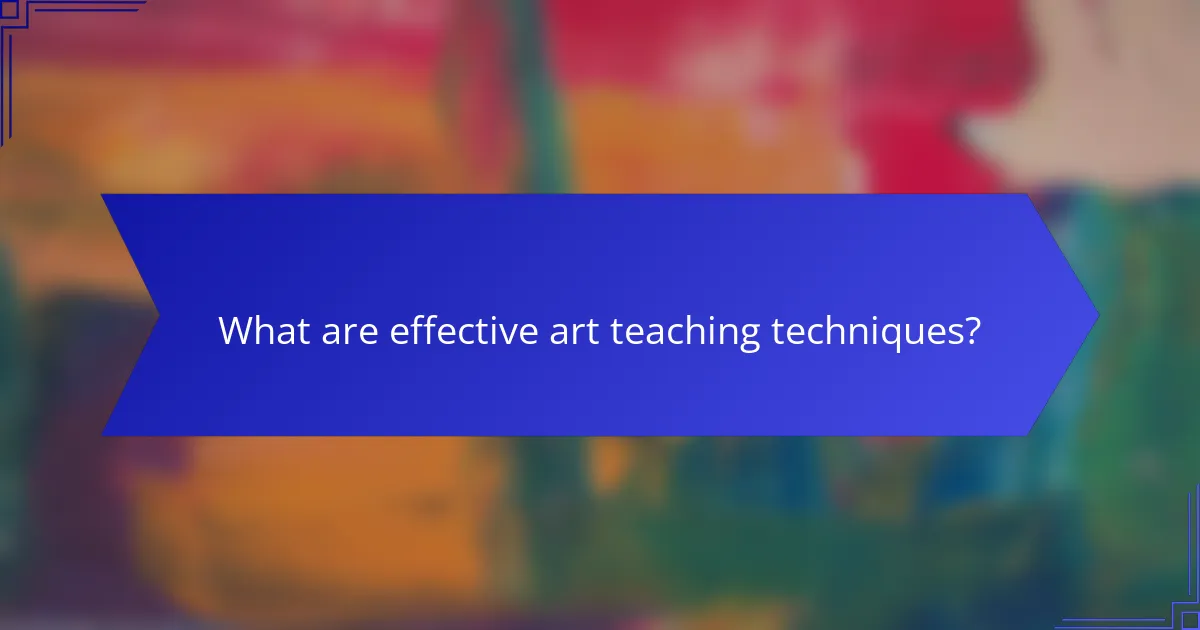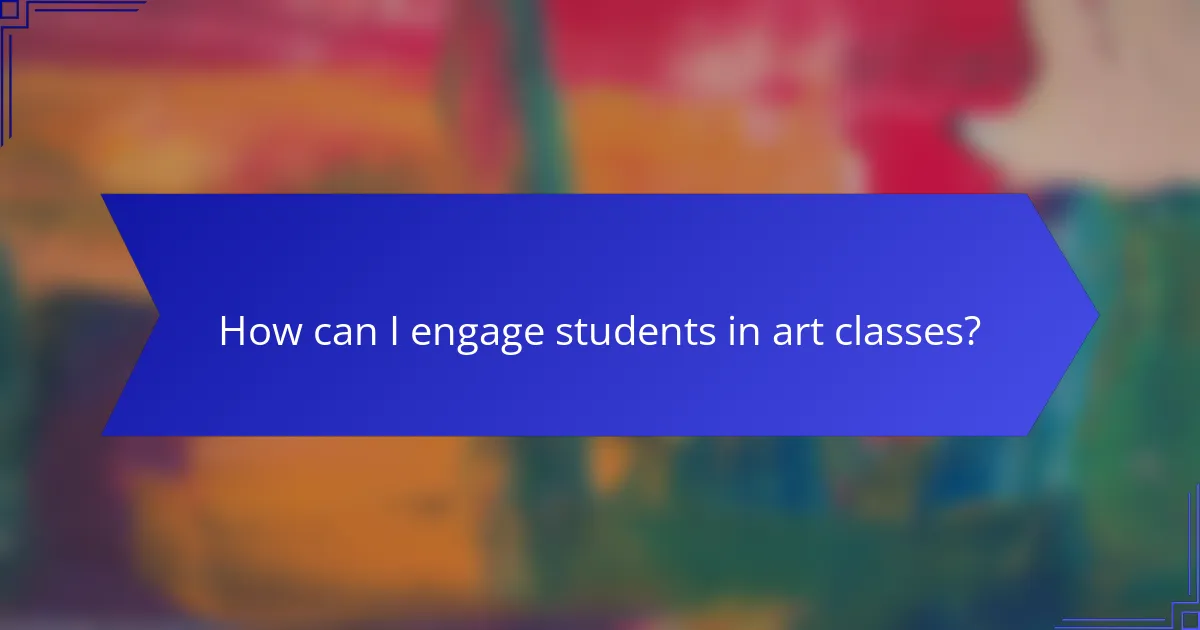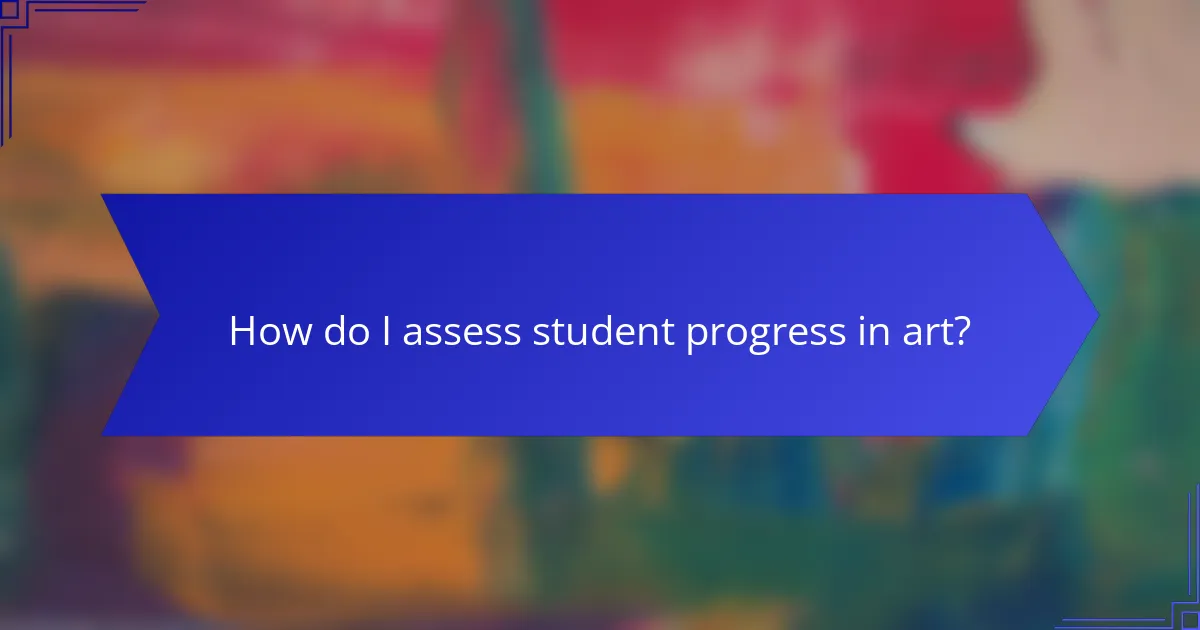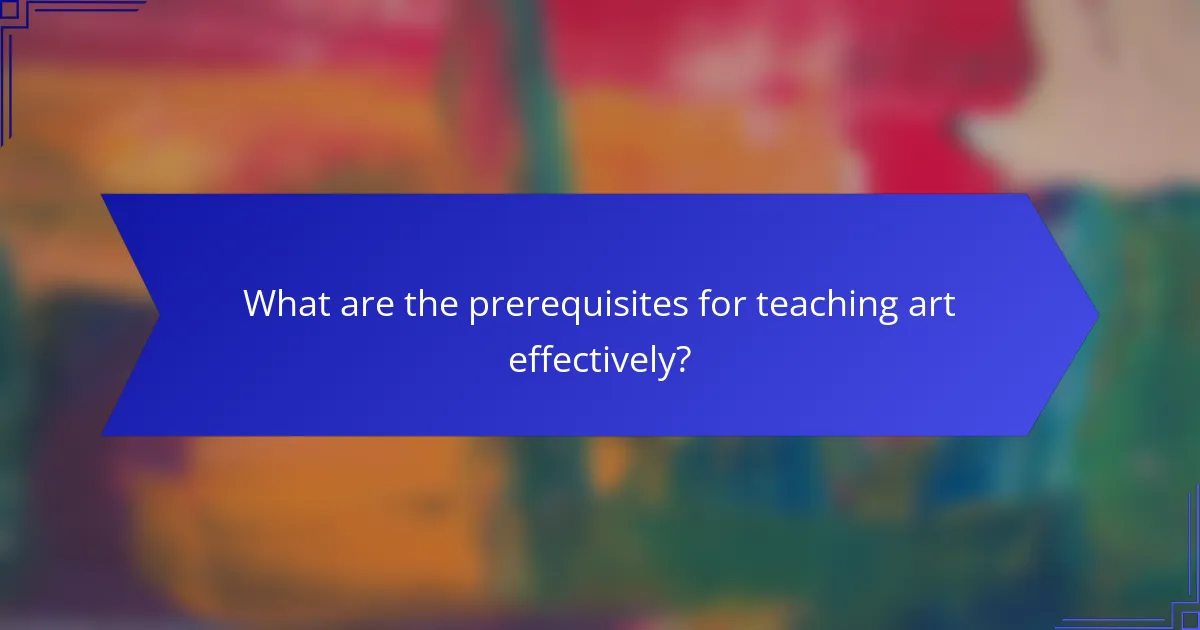Teaching art techniques effectively requires engaging students through hands-on experiences and collaborative activities that stimulate creativity. By utilizing diverse methods tailored to individual interests and learning styles, educators can foster a supportive environment that enhances participation and artistic skill development. Incorporating quality materials and digital tools further enriches the learning experience, making art education both dynamic and accessible.

What are effective art teaching techniques?
Effective art teaching techniques engage students through hands-on experiences, collaboration, and critical thinking. These methods foster creativity and help students develop their artistic skills in a supportive environment.
Project-based learning
Project-based learning involves students working on a specific art project over an extended period. This approach encourages exploration and allows students to apply various techniques while developing a deeper understanding of artistic concepts.
To implement project-based learning, set clear objectives and provide resources for students to research and gather inspiration. Encourage them to reflect on their process and outcomes, which enhances their learning experience.
Collaborative art projects
Collaborative art projects promote teamwork and communication among students. By working together, students can share ideas, techniques, and feedback, which enriches their artistic development.
Consider organizing group projects where each student contributes a unique element, such as a mural or a mixed-media installation. This not only fosters a sense of community but also allows students to learn from one another’s strengths.
Visual thinking strategies
Visual thinking strategies help students analyze and interpret art by focusing on observation and discussion. This method encourages critical thinking and enhances students’ ability to articulate their thoughts about art.
Incorporate activities like looking closely at artworks and discussing elements such as color, composition, and emotion. This practice can deepen their understanding and appreciation of art while developing their analytical skills.
Demonstration and practice
Demonstration and practice involve showing students specific techniques and allowing them to apply what they’ve learned. This hands-on approach is crucial for skill development in various mediums.
Regularly demonstrate techniques such as brushwork, color mixing, or printmaking, followed by practice sessions where students can experiment. Providing constructive feedback during these sessions can significantly enhance their learning outcomes.
Interactive critiques
Interactive critiques encourage students to engage with each other’s work through constructive feedback. This process helps them develop their evaluative skills and learn to articulate their artistic choices.
Facilitate critiques by establishing a respectful environment where students can share their thoughts openly. Use guiding questions to prompt discussion, helping students to reflect on their work and the work of their peers effectively.

How can I engage students in art classes?
Engaging students in art classes involves using diverse methods that resonate with their interests and learning styles. By incorporating technology, local resources, and fostering a supportive environment, teachers can enhance student participation and creativity.
Incorporating technology
Utilizing technology in art classes can significantly boost student engagement. Tools like digital drawing software, online galleries, and art apps allow students to explore their creativity in innovative ways.
Consider using platforms such as Adobe Creative Cloud or Procreate, which provide powerful features for digital art creation. Additionally, virtual reality (VR) can immerse students in art history or allow them to create 3D sculptures, making learning interactive and exciting.
Utilizing local art resources
Leveraging local art resources can enrich the learning experience by connecting students with their community. Organizing field trips to local galleries, museums, or artist studios can inspire students and provide real-world context to their studies.
Invite local artists to conduct workshops or demonstrations, allowing students to learn directly from professionals. This not only enhances skill development but also fosters a sense of belonging and appreciation for local culture.
Creating a supportive environment
A supportive classroom environment is crucial for fostering creativity and confidence in students. Encourage open dialogue and constructive feedback, allowing students to express their ideas without fear of judgment.
Implement strategies such as peer critiques and group projects to build collaboration. Recognize individual achievements and efforts, which can motivate students to take risks and explore their artistic potential.

What materials are essential for teaching art?
Essential materials for teaching art include quality art supplies, digital tools, and resource books. These elements support effective learning and creativity in art education.
Quality art supplies
Quality art supplies are fundamental for fostering creativity and skill development in students. Basic supplies should include a variety of paints, brushes, drawing materials, and canvases or paper suited for different techniques.
When selecting art supplies, consider the age and skill level of your students. For younger learners, non-toxic and washable materials are crucial, while advanced students may benefit from professional-grade products. A well-stocked art room can enhance the learning experience significantly.
Digital tools for art education
Digital tools have become increasingly important in art education, offering new ways to create and learn. Software like Adobe Creative Suite or free alternatives such as GIMP can help students explore digital art techniques.
Incorporating tablets and styluses allows for a hands-on approach to digital art. Ensure that students have access to tutorials and online resources to maximize their learning. Balancing traditional and digital methods can enrich the curriculum.
Resource books and guides
Resource books and guides provide valuable insights into art techniques, history, and theory. Look for comprehensive texts that cover a range of styles and mediums, which can serve as references for both teachers and students.
Consider including books that feature step-by-step instructions and visual examples. Additionally, online resources and databases can supplement physical books, offering up-to-date information and diverse perspectives on art education.

How do I assess student progress in art?
Assessing student progress in art involves a combination of qualitative and quantitative methods to evaluate skills, creativity, and understanding. Effective assessment strategies include portfolio reviews, peer feedback sessions, and self-assessment techniques, each providing unique insights into a student’s development.
Portfolio reviews
Portfolio reviews are a comprehensive way to assess a student’s artistic journey. They typically involve evaluating a collection of a student’s work over time, showcasing their skills, creativity, and growth. When conducting a portfolio review, consider the diversity of techniques used, the evolution of style, and the ability to articulate the concepts behind the artwork.
To make the most of portfolio reviews, set clear criteria for evaluation, such as technical skill, originality, and thematic coherence. Encourage students to present their portfolios with explanations of their choices, which can provide deeper insights into their artistic intentions.
Peer feedback sessions
Peer feedback sessions allow students to engage with each other’s work, fostering a collaborative learning environment. During these sessions, students can provide constructive criticism and praise, which helps them develop their evaluative skills while also gaining new perspectives on their own work.
To facilitate effective peer feedback, establish guidelines that encourage respectful and specific comments. Consider using structured formats, such as “two stars and a wish,” where students share two positive aspects and one area for improvement. This method promotes a balanced approach to feedback.
Self-assessment techniques
Self-assessment techniques empower students to reflect on their own progress and identify areas for improvement. This process can include journaling about their artistic experiences, setting personal goals, and evaluating their work against established criteria.
Encourage students to use checklists or rubrics for self-assessment, focusing on aspects like technique, creativity, and effort. Regular self-assessment can help students take ownership of their learning and develop critical thinking skills about their art practice.

What are the prerequisites for teaching art effectively?
To teach art effectively, instructors should possess a strong foundation in art techniques, a clear understanding of educational methods, and the ability to engage students creatively. Familiarity with various art mediums and styles, along with effective communication skills, enhances the teaching experience.
Understanding of Art Techniques
An effective art teacher must have a comprehensive grasp of various art techniques, including drawing, painting, sculpture, and digital media. This knowledge allows instructors to demonstrate skills accurately and provide constructive feedback. Teachers should continually update their skills to stay relevant with current trends and techniques.
Knowledge of Educational Strategies
Instructors should be familiar with different educational strategies that cater to diverse learning styles. Techniques such as project-based learning, collaborative activities, and differentiated instruction can enhance student engagement. Understanding how to assess student progress and adapt lessons accordingly is also crucial for effective teaching.
Ability to Engage Students
Engaging students in art requires creating a stimulating environment that encourages creativity and self-expression. Instructors can achieve this by incorporating interactive activities, allowing for exploration of personal interests, and fostering a supportive atmosphere. Regularly showcasing student work can also boost motivation and pride in their artistic endeavors.
